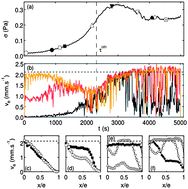Turbulent flows in highly elastic wormlike micelles†
Abstract
This work reports on an experimental study of elastic turbulence in a semi-dilute wormlike micelle system made of a highly elastic

* Corresponding authors
a
Laboratoire du Futur, CNRS UMR 5258, 178 avenue du Docteur Schweitzer, Pessac, France
E-mail:
julien.beaumont-exterieur@eu.rhodia.com
Fax: +33 05 5646 4790
Tel: +33 05 5646 4760
b Université de Lyon, Laboratoire de Physique, École Normale Supérieure de Lyon, CNRS UMR 5672, 46 Allée d'Italie, 69364 Lyon cedex 07, France
c Laboratoire Matière et Systèmes Complexes, CNRS UMR 7057, Université Paris Diderot, 10 rue Alice Domont et Léonie Duquet, 75205 Paris cedex 13, France
d Institut Universitaire de France, France
This work reports on an experimental study of elastic turbulence in a semi-dilute wormlike micelle system made of a highly elastic

 Please wait while we load your content...
Something went wrong. Try again?
Please wait while we load your content...
Something went wrong. Try again?
J. Beaumont, N. Louvet, T. Divoux, M. Fardin, H. Bodiguel, S. Lerouge, S. Manneville and A. Colin, Soft Matter, 2013, 9, 735 DOI: 10.1039/C2SM26760H
To request permission to reproduce material from this article, please go to the Copyright Clearance Center request page.
If you are an author contributing to an RSC publication, you do not need to request permission provided correct acknowledgement is given.
If you are the author of this article, you do not need to request permission to reproduce figures and diagrams provided correct acknowledgement is given. If you want to reproduce the whole article in a third-party publication (excluding your thesis/dissertation for which permission is not required) please go to the Copyright Clearance Center request page.
Read more about how to correctly acknowledge RSC content.
 Fetching data from CrossRef.
Fetching data from CrossRef.
This may take some time to load.
Loading related content
